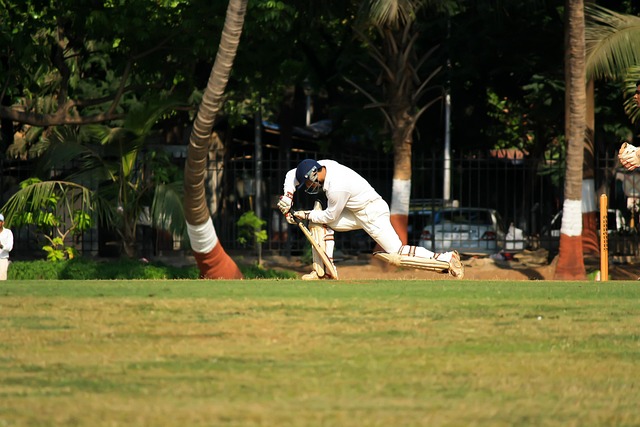
Understanding cricket ball swing dynamics, governed by physics and skill, is crucial for players and fans alike. Air resistance, spin, and bat-ball collision impact trajectory, creating strategic variations. Analyzing these through crowdsourced data enhances performance and fan engagement. This knowledge also opens career paths in coaching, analytics, journalism, and merchandise design while promoting fair play and sportsmanship. Environmental factors and equipment advancements further influence ball trajectory, making data-driven decisions vital for optimal cricket playing conditions.
In the fast-paced world of cricket, understanding why the ball swings is a game changer. This article delves into the intricate physics behind this vital aspect of the sport, exploring the interplay of gravity and angular momentum. We dissect the swing mechanics, where batter’s actions meet ball interactions, and analyze air resistance’s role in shaping trajectories. Additionally, environmental factors are considered to offer a comprehensive look at what makes the ball swing in cricket.
- Understanding the Physical Dynamics of Cricket
- The Role of Gravity and Angular Momentum
- Swing Mechanics: Battler's Action and Ball Interaction
- Air Resistance and Its Impact on Swing Trajectory
- Environmental Factors Influencing Ball Swing in Cricket
Understanding the Physical Dynamics of Cricket

In the fast-paced world of cricket, understanding the physical dynamics that govern the game is essential for both players and fans alike. The swing of a ball, be it delivered by a skilled bowler or hit by a master batsman, involves a complex interplay of forces and movements. This intricate dance involves the interaction of air resistance, spin, and the physics behind the bat-ball collision, creating an engaging spectacle that captivates cricket fans worldwide.
The journey from a bowler’s hand to the batsman’s stroke is a testament to crowd engagement strategies in cricket, with each action contributing to the game’s social media trends and merchandise sales. The art of swing bowling, for instance, relies on precise technique and strategic variations, such as reverse swing or seam movement, which can be analyzed using crowdsourced data to improve performance. Exploring these dynamics not only enhances fan experience but also opens up career paths in cricket, from coaching and analytics to sports journalism and merchandise design, giving us a call at cricket career paths for more information.
The Role of Gravity and Angular Momentum

In the dynamic world of cricket, understanding the ball’s swing is key to mastering both bowling and batting strategies. The interplay between gravity and angular momentum plays a pivotal role in this intricate movement. Gravity, as the dominant force on Earth, exerts its pull on the cricket ball, causing it to curve and swing through the air. This effect is particularly pronounced when the bowler delivers the ball with precision and speed. Angular momentum, generated by the initial rotation of the ball during the bowling action, further contributes to the swing. As the ball accelerates, this rotational energy builds, leading to a dramatic change in trajectory that can puzzle even the most skilled batters.
This combination of physical forces makes cricket fantasy games more exciting as players must consider not just the batter’s skills but also the strategic impact of the ball’s swing. For bowlers looking to enhance their fitness for cricket, understanding these principles is crucial. Similarly, venue management teams focused on hosting international cricket tournaments need to ensure optimal conditions for such intricate ball movements. Delving into the science behind the ball’s swing in cricket adds a layer of depth to the sport’s history timeline and team compositions, ultimately enriching the experience for fans worldwide. Find us at these prestigious events to witness the art of cricket in action!
Swing Mechanics: Battler's Action and Ball Interaction

In cricket, the swing of the ball is a complex interplay of physics, technique, and skill. The batter’s action plays a pivotal role in this dynamic. With each stroke, the batter generates force through their arms, shoulders, and core, transferring this energy to the cricket bat. The interaction between the bat and the ball at various angles and speeds creates different types of swing, such as seam or spin.
Understanding these mechanics is crucial for both batters and bowlers. Cricket match analysis tools help in studying player actions, ball interactions, and swing patterns. By delving into these intricacies, players can refine their techniques, enhancing performance and strategy. For instance, visiting us at cricket injuries and prevention anytime, you can explore resources that support mental health alongside physical conditioning, vital components for optimal play. Remember that the rule of cricket, which emphasizes fair play and sportsmanship, is also reflected in how players approach swing mechanics, ensuring a balanced and strategic approach to every ball.
Air Resistance and Its Impact on Swing Trajectory

In cricket, air resistance plays a significant role in determining the trajectory of a swinging ball. As the ball moves through the air, it encounters varying levels of drag caused by the surrounding atmosphere. This force acts in the opposite direction to the ball’s velocity, slowing its descent and potentially altering its course. The impact of air resistance can be substantial, especially for skilled bowlers who exploit these forces to achieve significant swing and variation in their deliveries.
Understanding air resistance is crucial for both cricket player agents and coaches when strategizing bowling tactics. By manipulating factors like ball shape, speed, and release point, bowlers can create unpredictable movements, making it more challenging for batsmen to read and play the ball accurately. This intricate interplay between physics and skill showcases the complexity of the sport and contributes to the excitement and unpredictability that cricket media and broadcasting captures so well. Moreover, appreciating these forces encourages fans to engage deeper with the game, appreciating the subtle nuances that separate a good bowler from a great one. Even the most dedicated cricket fan culture can learn something new when delving into these scientific aspects, enhancing their overall enjoyment of the sport. Similarly, exploring such topics can inspire cricket crowdsourcing data initiatives, providing valuable insights for both players and analysts alike. Interestingly, those interested in the sport can find us at cricket tourism and travel destinations, where they can witness the beauty of the game firsthand, while also supporting sustainable cricket initiatives.
Environmental Factors Influencing Ball Swing in Cricket

In cricket, understanding why the ball swings is key to mastering the game’s nuances. Several environmental factors significantly influence this phenomenon. Wind conditions play a pivotal role, with varying speeds and directions impacting both the batsman and bowler’s strategies. The pitch itself acts as a crucial variable; its composition, inclines, and wear patterns can cause the ball to swing or spin in unexpected ways. Moreover, temperature differences between the ball and the surrounding air can create a dramatic effect on its trajectory.
Tactics and strategy overview often revolve around leveraging these factors. Bowlers employ different types of deliveries like seam up, swing, and reverse swing, adapting them to conditions. Batsmen adjust their stances, footwork, and timing accordingly. Cricket history timeline shows that advancements in equipment, such as the introduction of modern balls with enhanced seams, have further refined the art of ball swing. Even cricket match analysis tools are designed to help players make data-driven decisions based on these environmental inputs. Find us at cricket venue management for more insights into optimizing playing conditions and enhancing the overall cricket experience.
In conclusion, the intricate dance of a ball swinging through the air in cricket is a result of a complex interplay between physical dynamics, gravity, angular momentum, air resistance, and environmental factors. By understanding these elements, we gain insights into the fascinating science behind this essential aspect of the game, enriching our appreciation for both the sport and its nuances. The physics behind the swing continue to captivate and challenge players, making cricket a true testament to human ingenuity and the beauty of natural laws in action.






